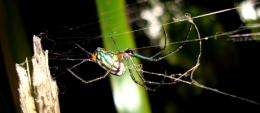Researchers Uncover Identity Of Spider Discovered By Darwin More Than A Century Ago

(PhysOrg.com) -- Researchers at The George Washington University recently uncovered the identity of a spider that was originally found by Charles Darwin in Brazil more than a century and a half ago. Using notes taken by Darwin himself, the researchers uncovered the identity of the species, "Leucauge argyrobapta," and many aspects of the identity of the genus "Leucauge" that will now help taxonomists understand this complicated lineage of orb-weaving spiders to which this species belongs.
“This finding greatly facilitates future work in one of the most diverse spider genera,” said Dr. Dimitar Dimitov, a postdoctoral researcher at GW. “At the same time it shows us that looking in our backyard can often present us with surprising and significant findings.”
The first specimen was found in the Tijuca forest located in the heart of Rio de Janeiro and collected by Darwin when he visited during the voyage of the H.M.S. Beagle in 1832. After making the voyage back to London with Darwin for study, the specimen was somehow lost. More than a century and a half later, the GW researchers traveled to Rio to complete the research started by Darwin and found the specimen living in the botanical garden in Rio’s National Museum. Soon thereafter, the researchers were able to realize the importance of these newly collected specimens and understand the only spider name that can be attributed to Darwin. Now, taxonomists will be able to understand even more about this orb-weaving group of spiders and hope that it leads to additional species recognition.
“Deciphering the identity of this species collected by Darwin - the type species of the genus - removes an important obstacle towards a better understanding of the classification of this large and diverse group of spiders,” said Dr. Gustavo Hormiga, Ruth Weintraub Professor of Biology at GW.
"Leucauge argyrobapta," a name meaning “with a bright gleam, dipped in silver,” is part of the orb-weaver family Tetragnathidae, also known as long-jawed spiders. Orb-weaving spiders build spiral, wheel-shaped webs that are often found in gardens, fields and forests. "Leucauge argyrobapta" turned out to be the same species as the orchard spider commonly found in the U.S.
This research is being funded by the National Science Foundation’s program “Partnerships for Enhancing Expertise in Taxonomy.”
Dr. Dimitrov is currently a postdoctoral researcher at the Zoological Museum at the University of Copenhagen. He conducted the research on "Leucauge argyrobapta" with Dr. Hormiga as a postdoctorate at GW from 2005 to 2009 and later as an adjunct research associate. Dr. Hormiga is the Ruth Weintraub Professor of Biology and his work focuses on the systematics and evolutionary biology of spiders with emphasis on orb-weavers and their close relatives.
The article, “Mr. Darwin’s mysterious spider: on the type species of the genus Leucauge White, 1841 (Tetragnathidae, Araneae),” appeared in the March 11, 2010, issue of "Zootaxa."
Provided by George Washington University















